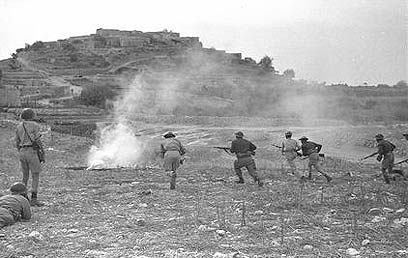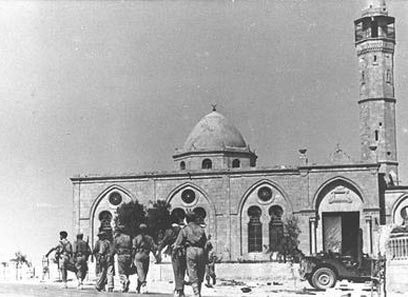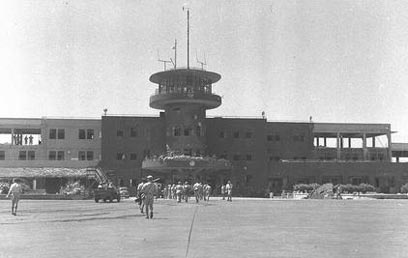
War of Independence (1948)
None
The United Nations declared the establishment of the State of Israel on November 29, 1947, as its members voted in favor of the partition of Palestine into Jewish and Arab states. The British Mandate in Palestine officially ended on May 15, 1948, but since that date fell on a Shabbat, David Ben-Gurion, elected the new nation's first prime minister, declared it a State on Friday, May 14.
May 15, 1948 saw the first bombing of Tel Aviv by an Arab air force, as Arab ground troops invaded the country. Israel's fight for independence had begun and was to last until July 1949.
The War of Independence can be divided into four stages:
- The Jewish "civil war", which took place during the British Mandate in Palestine, and during which the Jewish settlement was constantly battling local Arab militias.
- The fighting which broke out on May 15, 1948, immediately after the UN declared the Jewish state viable. This stage ended with a UN détente, declared on June 11, 1948.
- The third stage, which took place between July 9, 1948 and July 18, 1948. Dubbed "the 10-day battles," it ended with a second UN détente.
- The fourth and last stage, which saw consecutive fighting and ended with ceasefire agreements between the fighting parties.

The fighting
The Arab invasion which began on May 15, 1948 seemed lacking in coordination. The invading forces, which included Egyptian, Syrian, Jordanian, Lebanese and local Palestinians troops, had neither a joint command, nor an evident plan to instate a local Palestinian regime in the land – once conquered – or divide it among themselves. The invasion was sanction by the Arab world, which having a vested interest in the fighting, gave the major armies fighting Israel reinforcements in the form of Iraqi, Sudanese and Saudi Arabian forces.May 18, 1948 saw the formal introduction of the Israel Defense Forces, which numbered 25,000 troops. The new army quickly formed three command directorates in the country's northern, central and southern sectors, made up of six infantry divisions, a small air force and a smaller navy. Premier and Defense Minister David Ben-Gurion named Yaakov Dori as his chief of staff and Yigael Yadin as head of the Operations Branch, and the three set out to orchestrate the fighting.
The Egyptian, Syrian Jordanian and Lebanese armies staged ground incursions form their respective directions, as the Iraqi military took over attacking Israel via several sectors on the northern Trans-Jordanian front. Lebanese forces attempted to infiltrate from the north via the Galilee panhandle, but were bridled by the IDF at Ramot Naftali. Syrian forces infiltrated the Jordan Valley in an attempt to take Tiberias and Nazareth, but were stopped in their tracks. Trans-Jordanian forces took over some eastern territories – designated by the partition plan for the future Palestinian state – but refrained from invading the Jewish State at that point.

Taking Beersheba (Archive photo: GPO)
The Arab Legion focused its offensive on Jerusalem, as Iraqi troops took over the Naharayim power plant and Samaria. They were making their way towards Netanya, when they were halted. Meanwhile, the Egyptian Military – the biggest force amongst the Arab armies – made its way both along the Mediterranean shoreline and forging through Beersheba and Hebron towards southern Jerusalem, placing the Jewish communities on its route under siege. The Egyptians were finally bridled north of Ashdod, in the first-ever Israeli Air Force battle.
Jerusalem proved the most formidable front for Israel, as Arab Legion, Egyptian and Palestinian troops joined forces in the fighting. The IDF struggled to free the sieged Jewish Borough, but to no avail, and it was taken on May 28, 1948. The IDF was able, however, to take the Burma Road – south of the city – and use it to supply the borough with basic provisions until the war came to its end.
June of 1948 saw the UN Security Council call for a four-week détente in the fighting. Declared on June 11, 1948 it was generally observed by all of the fighting parties. IDF forces used the "breather" to restock on weapons, despite the arms embargo imposed by the UN at the beginning of the war.
Once the détente came to its end, the IDF launched several offensives, focusing on the Jerusalem and Galilee sectors. The Israeli forces were able to retake Lod and Ramla and push the Arab Legion away from Tel Aviv, and later laid claim to the Western Galilee. Jerusalem and the Negev, however, were still out of reach. The next series of battlers, later dubbed "the 10-day battles" ended with yet another UN détente. The temporary respite in fighting ended on October of 1948, with the IDF launching offensive strikes on all fronts.

Taking the Lod airfield (Archive photo: GPO)
Closing ranks
The last stage of the War of Independence was riddled with IDF offensive strikes: The Lebanese army was pushed back altogether, operations Danny and Horev saw the Israeli Military take back Beersheba and more of the south, and in October, the Israeli Navy engaged in its first and only battle with the Egyptian warship el-Amir Faruk, sinking it off Israel's southern coast. IDF forces were also able to essentially lift the siege off Jerusalem and take over all of the Galilee area. Operation Ovda saw the IDF take back the entire Negev area, effectively ending the war.
Egypt signed a ceasefire agreements with Israel on February 24, 1949. Lebanon was the next to agree to a ceasefire, which was signed on March 23, 1949. A ceasefire agreements with Jordan followed on April 4, 1949, and last to agree to a armistice was Syria, on July 17, 1949.
The War of Independence claimed the lives of 4,000 Israeli troops and 2,000 Israeli civilians.
Related links:
• Selected documents related to the War of Independence (Ministry of Foreign Affairs)










